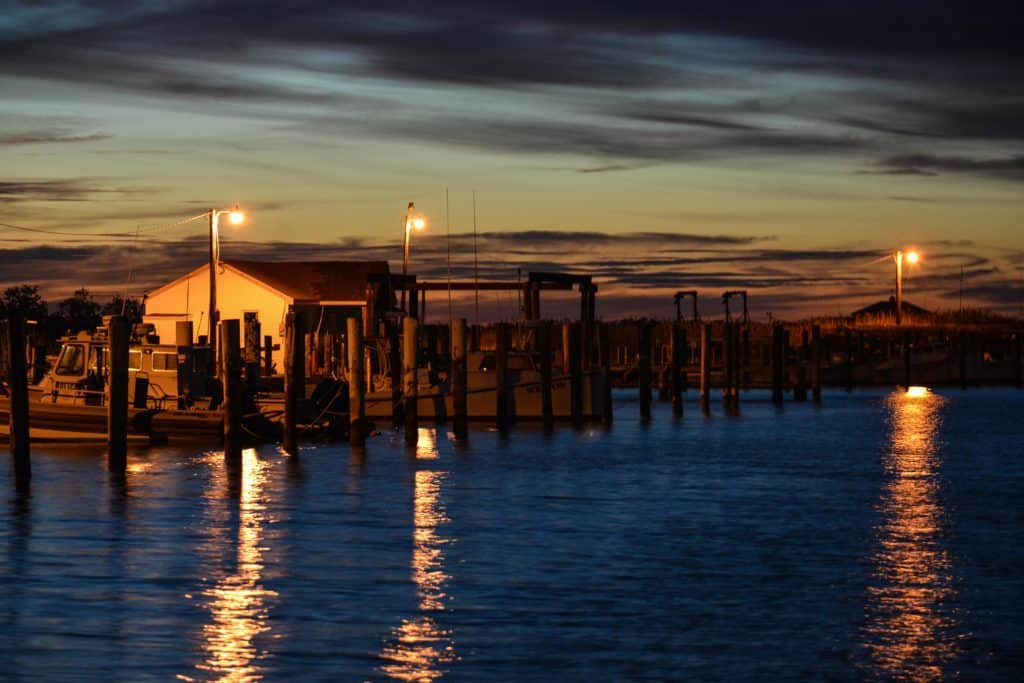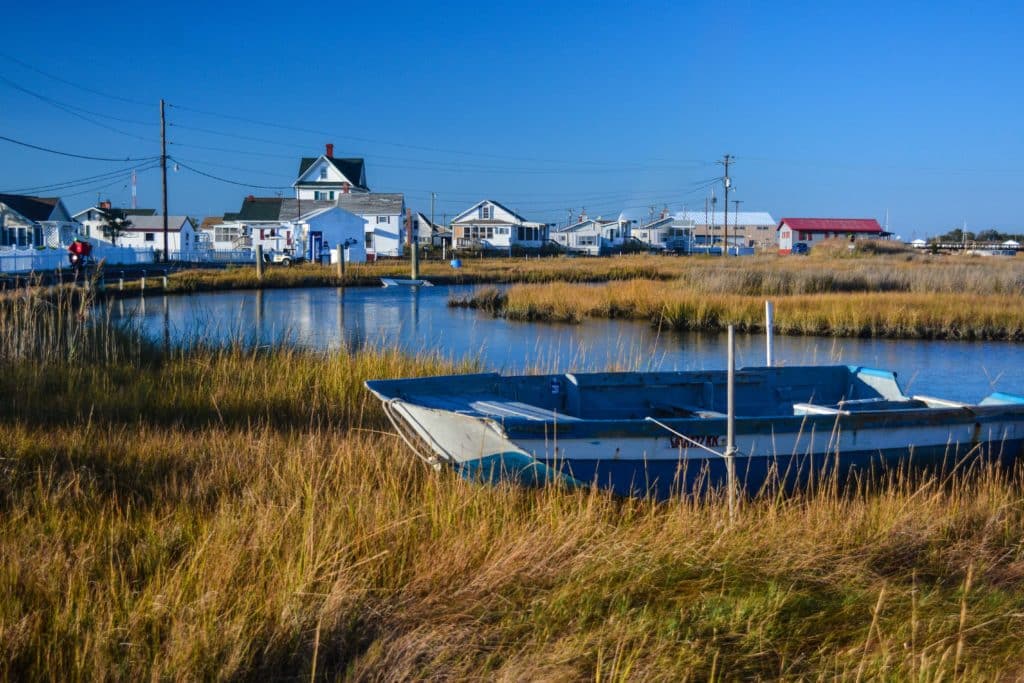
If you ever want to visit Tangier Island, the first thing you need to know is that you won’t see it until you’re very close. As we approached from the west, I was nonplussed as we sailed along on Ukiyo, our Catalina 34. I double-checked the chart plotter and GPS; I knew it was out there, but I didn’t see anything.
Finally, a solitary water tower poked its round head out of the Chesapeake. Then, soon after, a row of small homes and trees materialized. Other structures appeared, miragelike, but the land you’d expect to see under all this remained hidden.
It wasn’t until we were about to turn into the dredged channel that bisects the island, officially listed at 2.95 feet above sea level, that I fully saw the presence of land and a town. Wait, that last sentence is wrong; the dredged channel bisected the island 80 years ago. Since then, the northern half has succumbed to the waves, and with the inhabitants of that area gone, nothing remains but tidal marsh, broken headstones and the detritus of the homes that were once there. Tangier, you see, is slowly vanishing into the bay.
We motored in on the rising tide and grabbed a slip at Parks Marina next to two other visiting sailboats. I first sailed here in 2000 and was amazed at what I saw: a tightknit, religious community of 450 that traces its origins directly to 17th-century England. The watermen eked out a living by harvesting blue crabs and oysters, and their stilted shanties lined the main thoroughfare.
I returned last summer with my wife and two teenage daughters, who — surprise — were not excited to be there. This visit was the planned destination of a voyage that began in Jacksonville, Florida, a month earlier. Underway, we dealt with contrary tides, engine problems, wilting heat and complaints. I kept reminding them of why we were doing this — of why it was worth the reduced YouTube time. “I want you to see for yourself,” I told them. “The heart and soul of the Chesapeake, and why I love this place.”
I was careful not to add, “before it’s gone forever.”
The island has been in the news recently as residents are attempting to convince the federal government to build a wall of riprap that would protect their northern and eastern shores from further erosion. It won’t come cheap; the low end of the estimate is $30 million. In June, Mayor James Eskridge received a call from President Donald Trump, who is sympathetic to their cause. “You talk about a wall?” the mayor had said on CNN. “We’ll take a wall. We’d like to have a wall all the way around Tangier!”

There is precedent in the bay for what they are asking: Nearby Hart-Miller and Poplar islands were both in the process of vanishing when the Army Corps of Engineers rebuilt them with a repurposed channel dredge and rocks. They are now both stable and used as a park and wildlife refuge.
Since 1850, Tangier has lost a staggering 66 percent of its landmass. Dave Schulte, a marine biologist with the Army Corps of Engineers who built the wall that protects the airport along the island’s western edge, has studied the changing island for 15 years. He attributes the losses to a combination of wave-induced erosion and sea-level rise, and estimates that at the current rate, the island will have to be abandoned in perhaps 25 years. “They don’t have a lot of time,” he said.
We arrive on a good day: The sun is shining; streets and yards are dry. A bad day here is one where there is a foot of brackish water on the streets, making them impassable except by foot or truck. A cheery sign greeted us: “Welcome to Tangier Island, Farmers of the Chesapeake Bay.” Kids on golf carts and bicycles zoomed to and fro, and feral cats darted between old wooden buildings. We ate dinner in a nearly deserted Lorraine’s seafood restaurant, where crab, in every form imaginable, dominated the menu. Later, I commented to marina owner Milton Parks about the surfeit of cats, and he smiled mischievously at me. “You want to take one with you when you go?” he asked.
As the sun set, we strolled past graves of prior generations, and the only combined K-12 school in the state of Virginia. One of the few island structures built for the harsh realities to come, the school rests on thick wooden piles 8 feet off the ground. Across from the playground, the water tower was festooned with the two things these islanders hold most dear: the cross and the crab. We walked briskly along the western ridge near the airstrip, swatting flies as we went. The wall, if approved, will not solve the problem. It will only buy time for the island, perhaps another century. Sooner or later, the rising sea will force remaining residents to make an orderly retreat to the mainland and move on with their lives, something that growing numbers of the young adults are already doing.
Early the next morning we threw our lines and headed eastward toward Crisfield, another community that faces future flooding and difficult choices. It’s a strange feeling, sailing away from a place that might not be there the next time you come back.
“It can be depressing up here when you see these places that used to be part of a thriving community,” said Eskridge as he looked at the town from the helm of his deadrise workboat. “It’s all gone now.”
– – –
Robert Beringer is a Florida-based freelance marine journalist. He learned to sail on the Great Lakes in a Hobie 16 and has since logged more than 28,000 miles under sail. His first book, Waterpower!, a collection of marine short stories, is available at Barnes & Noble.








